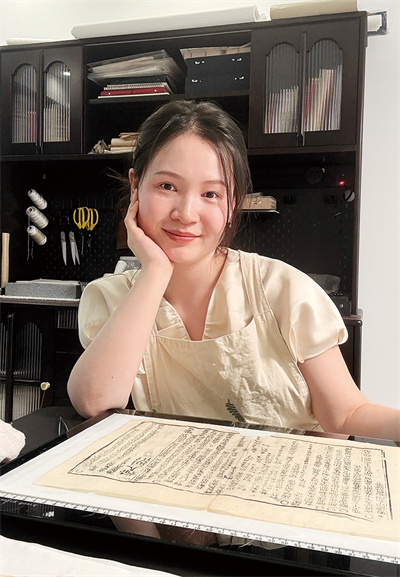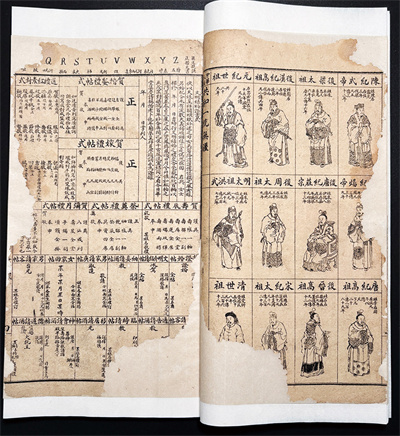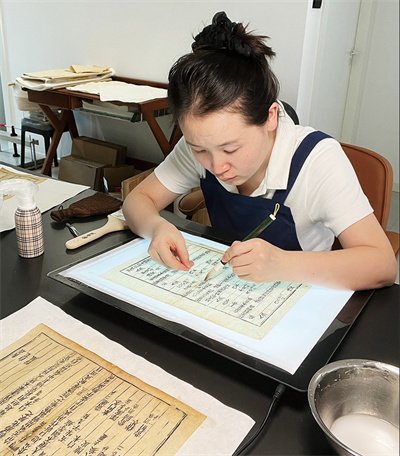
Li Yangyang has built a career for herself in ancient book restoration.[Photo provided to China Daily]
At 30, Li Yangyang never imagined that her degree in international business would lead her to a career in ancient book restoration. From starting as a novice in the workplace to founding her own restoration studio, she spent six years carving out a niche in this specialized field.
Today, she not only restores valuable ancient texts but also inspires lots of young people to engage with this traditional craft through social media. Li's journey reflects the transformation of ancient book restoration from a perceived "old craft" into a vibrant, emerging field amid a broader revival of traditional culture.
In 2017, Li, a native of Wuhan in Hubei province, had just graduated from college and was exploring various job opportunities. Despite trying several roles, she felt unfulfilled.
One day, she came across a cultural technology company looking for ancient book restorers and offering training to apprentices with no prior experience. Intrigued, she submitted her resume and got the job.
For Li, ancient book restoration was an entirely new field. The company paired her with experienced colleagues for hands-on training and frequently invited renowned industry experts to give lectures.
After an intensive six-month apprenticeship, she began taking on simple restoration tasks independently.
Restoring ancient books is more challenging than it appears. A typical restoration project involves over 20 steps, including photographing for archival purposes, preparing paper materials, disassembling books, cleaning, binding, and more.
Depending on the extent of the damage, Li can restore anywhere from 30 pages to just one or two pages a day, with fees ranging from 20 to 200 yuan per page.
"Book bricks" is the colloquial term restorers use for ancient books that have hardened into solid blocks. Some books are so damp that the pages stick together completely, and even the initial step of "flattening the pages" can take an entire day, with the slightest mistake risking a tear.
Aesthetics pose another significant challenge. Ancient book restoration isn't just about "patching up" — the proportions of the margins and the color of the backing paper must align with the original book's character.
Li believes that working in ancient book restoration, especially for beginners, requires a sense of reverence and a calm mindset.
"Before starting a restoration, you must ask yourself: Can my skills handle this? If not, it's better to seek help from a master rather than risk making things worse," she explained. "Over-restoration can be more damaging than leaving the book untouched."
Li also advised that if you're feeling emotionally overwhelmed, it's best to avoid working on ancient books. She recalled a time when she nearly crumpled a book in frustration.
"Being overly joyful, laughing, or joking around isn't ideal either. Even cutting a millimeter too much can make restoration impossible later on."

Li Yangyang has built a career for herself in ancient book restoration.[Photo provided to China Daily]
Technical upgrading
To improve her skills, Li attended several training sessions at institutions including the National Library of China in Beijing and the Yunnan Provincial Library in Kunming, where she mastered techniques such as digitization, cataloging, and facsimile reproduction of ancient books.
"These may not involve directly 'repairing' books, but they are just as crucial for preserving and passing on ancient culture," she said.
According to Li, digitization involves scanning ancient books to create a searchable database. Cataloging establishes a complete identity archive for each book, classifying them into categories like classics, history, philosophy, and literature, and determining their editions, sizes, cultural relic grades, and damage levels.
The demand for facsimile production of ancient books has surged in recent years. "On one hand, it's to protect the original copies during exhibitions. On the other hand, the facsimile books themselves are exquisitely made and will be valuable in a few hundred years as well. This process essentially continues and passes on the importance of cultural preservation," Li elaborated.
She also focuses on the application of new technologies in ancient book restoration. For example, an AI restoration system can scan damaged areas, identifying issues like insect holes and mold spots, then automatically generate restoration plans and predict how the paper will age over time.
Fiber analysis is another technique Li is currently studying. By staining the paper with iodine reagents and examining it under a microscope, she can determine its composition. For instance, if the paper is made from bamboo, it can't be repaired with mulberry bark paper — much like how blood transfusions require matching blood types.

Li Yangyang has built a career for herself in ancient book restoration.[Photo provided to China Daily]
Market potential
With the nation's growing emphasis on cultural heritage preservation, the ancient book restoration industry is experiencing unprecedented opportunities for development.
"The demand comes not only from official organizations like museums and libraries but also from private book collectors," Li explained. "Ancient books are becoming more accessible to the public. Some even search their homes for family heirloom books."
Last October, Li established her own studio, taking on orders from both institutions and individuals, with the workload currently split evenly.
Since February, Li has been posting videos on platforms like Xiaohongshu (RedNote) and Douyin (the Chinese version of TikTok), hoping to use social media to bring ancient books into the mainstream.
She discovered that videos featuring technical tips and severely damaged books are particularly popular — the former gives viewers the sense that "they can try it themselves", while the latter offers a "healing" experience.
Li noted that most of her followers are young people, reflecting a trend in talent development within the field in recent years.
Since 2017, many universities have begun offering courses in ancient book restoration, marking a shift from the traditional "master-apprentice" model to a more academic approach.
To Li, ancient book restoration is not just about extending the life of paper but also about preserving cultural heritage. Nowadays, clients are restoring not only common books but also genealogy books, land deeds, maps, local chronicles, and other types of documents — ancient books have truly moved from museum displays into everyday homes.
"A book from hundreds of years ago may seem distant, but it can subtly influence our lives. I hope ancient books will become a more common aspect of life, allowing more people to experience them," Li said.